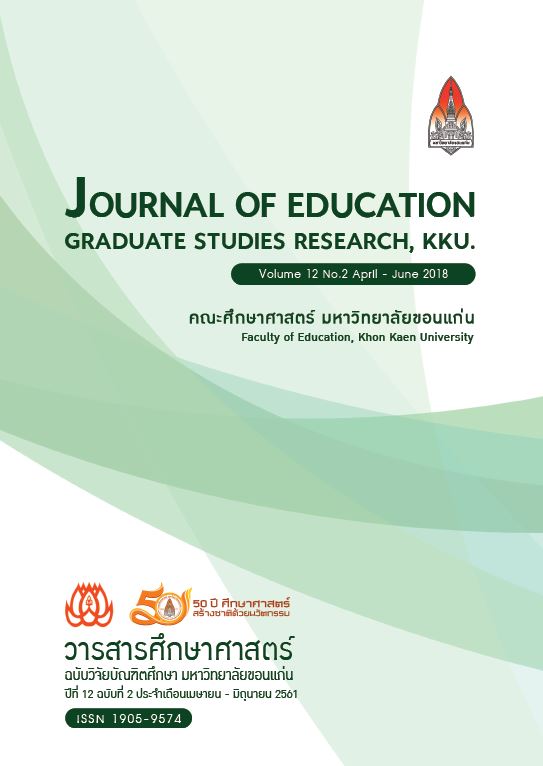Levels of Scaffolding Strategies in Mathematics Classroom Using Lesson Study and Open Approach
Main Article Content
Abstract
This study aimed to analyze levels of scaffolding strategies in mathematics classroom using lesson study and open approach. The target group consisted of one teacher and 7 grade-7 students in Ban Bueng-niam Bueng-Krainnoon Tahin School by establishing a classroom using lesson study and open approach in 7 learning periods of a positive number and negative number of Mathematics. A researcher had been collecting the data by making video between collaboratively designing research lessons, collaboratively observing teaching and collaboratively doing post-discussion or reflection on teaching practice. Data used for an analysis were composed of 1) protocol of collaboratively designing research lessons, collaboratively observing teaching and reflection the research lessons , 2) data of the students’ work. Data analysis sequence of lesson study and open approach according to Inprasitha’s idea (2011) and strategies for scaffolding learning from Anghileri (2006).
The study results revealed that
- Collaboratively design a research lessons, found scaffolding strategies Level 1 including 1) grouping students to achieve learning 2) the use of teaching materials to support students’ thinking and 3) sequencing the problem and order for students to learn continuously. And level 2 including 1) reviewing of the prior knowledge or experience of the students.
- Collaboratively Observe the research lesson, found scaffolding strategies as follows
2.1 Posing open-ended problem, found scaffolding strategies Level 1 including 1) grouping students to achieve learning 2) the use of teaching materials to support students’ thinking and 3) sequencing the problem and order for students to learn continuously. And level 2 including 1) reviewing of the prior knowledge or experience of the students. 2.2 Students’ self learning, found scaffolding strategies Level 1 including 1) grouping students to achieve learning 2) the use of teaching materials to support students’ thinking. And level 2 including 1) reviewing of the prior knowledge or experience of the students. 2.3 Whole class discussion and comparison, found scaffolding strategies Level 2 including 1) reviewing of the prior knowledge or experience of the students and 2) restructuring of new thinking. And level 3 including 1) giving the opportunity for the students to summarize the mathematical conceptual and 2) posing the question for the students to making connections the mathematical conceptual. 2.4 Summing-up by connecting students’ emergent mathematical ideas, found scaffolding strategies Level 3 including 1) giving the opportunity for the students to summarize the mathematical conceptual and 2) posing the question for the students to making connections the mathematical conceptual.
- Collaboratively discuss and reflect on the research lesson, teacher reflected about used scaffolding strategies including level 1, before interacting with their students, teacher scaffold learning with environmental provision. It caused the students had problems and they need solve problems. Level 2, teacher reviewed of the prior knowledge of the students and encouraged with their students to solved problems until they had the restructuring of new thinking. And Level 3, teacher gave the opportunity for the students to summarize and making connections about the mathematical conceptual caused to students can making connections and summarize according the goal of the lesson
Article Details
References
_______. (2555). หลักสูตรแกนกลางการศึกษาขั้นพื้นฐาน พุทธศักราช 2551. กรุงเทพฯ: ชุมนุมสหกรณ์การเกษตรแห่งประเทศไทย
ปรีชา ศรีเรืองฤทธิ์. (2549). การใช้แนวคิด เรื่อง พื้นที่ รอยต่อพัฒนาการ (Zone of Proximal Development) ของวิก๊อตสกี้ เพื่อพัฒนารูปแบบการเรียนการสอนการเขียนภาษาอังกฤษ สำหรับนักศึกษาระดับอุดมศึกษา. วิทยานิพนธ์ปรัชญาดุษฎี บัณฑิต สาขาวิชาหลักสูตรและการสอน บัณฑิตวิทยาลัย มหาวิทยาลัยขอนแก่น.
พิมพ์ลักษณ์ มูลโพธิ์. (2549). การสื่อสารในการเรียนรู้ คณิตศาสตร์ในบริบทวัฒนธรรมในชั้นเรียน: กรณีศึกษาชั้นเรียนไทยและชั้นเรียนญี่ปุ่น. วิทยานิพนธ์ศึกษาศาสตรมหาบัณฑิต สาขาวิชาคณิตศาสตรศึกษา บัณฑิตวิทยาลัย มหาวิทยาลัยขอนแก่น.
ไมตรี อินทร์ประสิทธิ์. (2549). การใช้วิธีการพัฒนากระบวนการคิดของนักเรียนแบบ Open Approach เพื่อส่งเสริมการพัฒนาวิชาชีพครู คณิตศาสตร์แบบ Lesson Study Approach. (รายงานวิจัยฉบับสมบูรณ์). ขอนแก่น: มหาวิทยาลัยขอนแก่น.
ไมตรี อินทร์ประสิทธิ์ และคณะ. (2546). การปฏิรูปกระบวนการเรียนรู้ของวิชาคณิตศาสตร์ในโรงเรียนโดยเน้นกระบวนการทางคณิตศาสตร์. ขอนแก่น: ขอนแก่นการพิมพ์.
สันติ บรรเลง. (2558). การตั้งคำถามช่วยเหลือทางการ เรียนเพื่อส่งเสริมการให้เหตุผลทางพีชคณิตในชั้นเรียนที่ใช้การศึกษาชั้นเรียนและวิธีการแบบเปิด. วารสารศึกษาศาสตร์ มหาวิทยาลัยขอนแก่น, 38(3), 126-132.
สำนักงานคณะกรรมการการศึกษาขั้นพื้นฐาน. (2554). สอนคณิตศาสตร์ตามแนวคิด Brain-Based Learning. กรุงเทพฯ: สำนักงาน.
Anghileri, J. (2006). Scaffolding Practices That Enhance Mathematics Learning. Journal of Mathematics Teacher Education, 9(1), 33–52.
Inprasitha, M. (2011). One Feature of Adaptive Lesson Study in Thailand: Designing a Learning Unit. Journal of Science and Mathematics Education in Southeast Asia, 34(1), 47-66.
McCosker, N. & Diezmann, C.M. (2009). Scaffolding students’ thinking in mathematical investigations. Australian Primary Mathematics Classroom, 14(3), 27-32.
Nohda, N. (2000). A study of “Open-Approach” Method in School Mathematics Teaching. Paper presented at the 10th ICME, Makuhari, Japan.
Wood, D., Bruner, J.S. & Ross, G. (1976). The role of tutoring in problem solving. Journal of Child Psychology and Child Psychiatry, 17(2), 89-100.

